2007 Hyundai Santa Fe Car seat
[x] Cancel search: Car seatPage 21 of 355
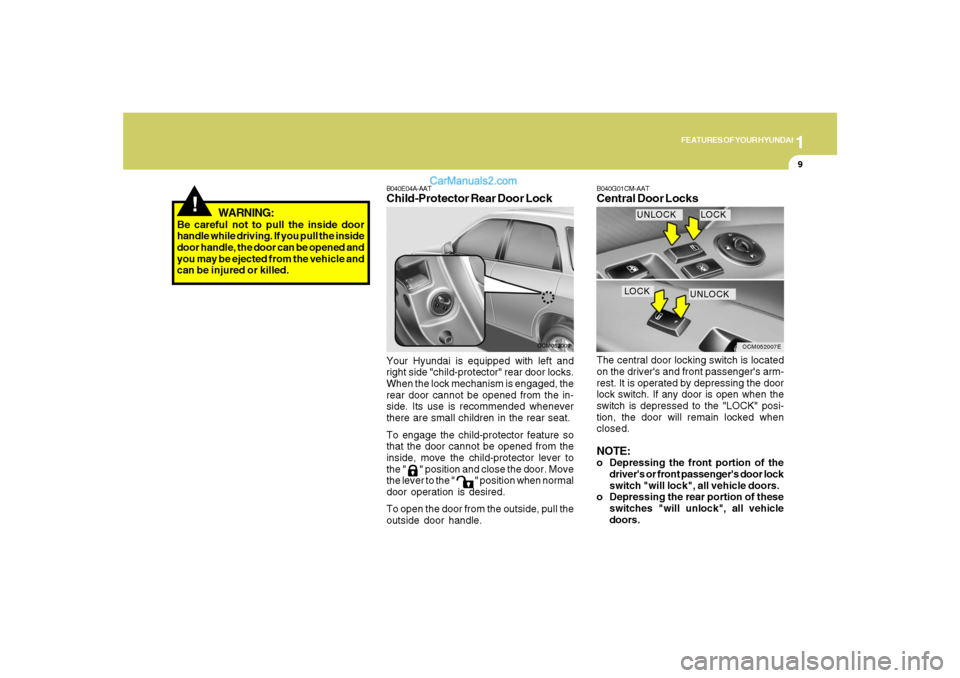
1
FEATURES OF YOUR HYUNDAI
9
WARNING:
Be careful not to pull the inside door
handle while driving. If you pull the inside
door handle, the door can be opened and
you may be ejected from the vehicle and
can be injured or killed.
!
B040E04A-AATChild-Protector Rear Door LockYour Hyundai is equipped with left and
right side "child-protector" rear door locks.
When the lock mechanism is engaged, the
rear door cannot be opened from the in-
side. Its use is recommended whenever
there are small children in the rear seat.
To engage the child-protector feature so
that the door cannot be opened from the
inside, move the child-protector lever to
the "
" position and close the door. Move
the lever to the "
" position when normal
door operation is desired.
To open the door from the outside, pull the
outside door handle.
OCM052009
B040G01CM-AATCentral Door LocksThe central door locking switch is located
on the driver's and front passenger's arm-
rest. It is operated by depressing the door
lock switch. If any door is open when the
switch is depressed to the "LOCK" posi-
tion, the door will remain locked when
closed.NOTE:o Depressing the front portion of the
driver's or front passenger's door lock
switch "will lock", all vehicle doors.
o Depressing the rear portion of these
switches "will unlock", all vehicle
doors.
UNLOCK LOCK
LOCK
UNLOCK
OCM052007E
Page 35 of 355
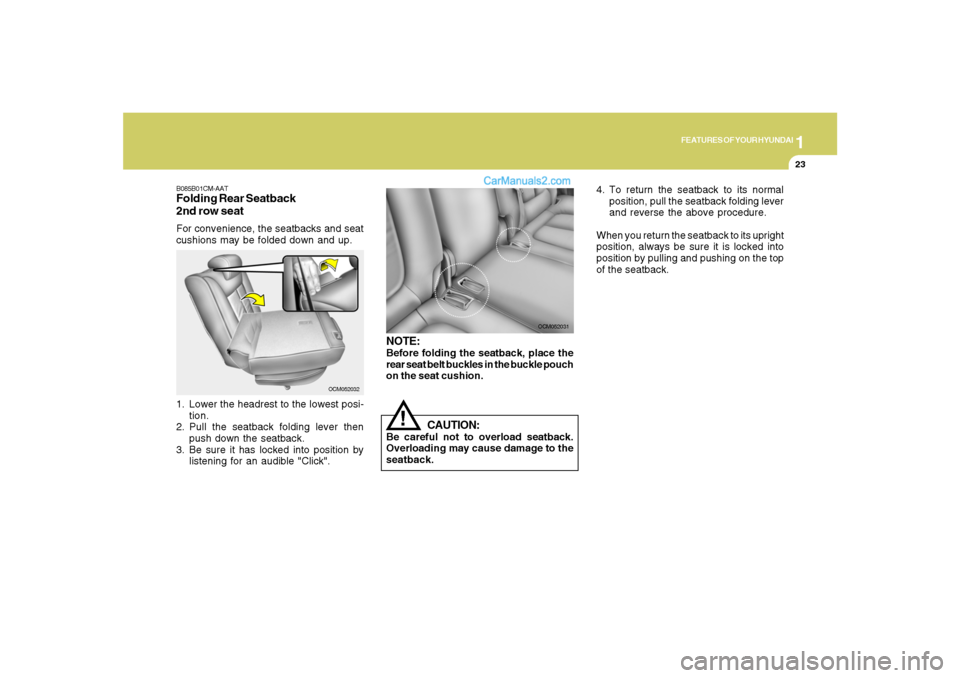
1
FEATURES OF YOUR HYUNDAI
23
OCM052032
B085B01CM-AATFolding Rear Seatback
2nd row seatFor convenience, the seatbacks and seat
cushions may be folded down and up.
1. Lower the headrest to the lowest posi-
tion.
2. Pull the seatback folding lever then
push down the seatback.
3. Be sure it has locked into position by
listening for an audible "Click".4. To return the seatback to its normal
position, pull the seatback folding lever
and reverse the above procedure.
When you return the seatback to its upright
position, always be sure it is locked into
position by pulling and pushing on the top
of the seatback.
OCM052031
!
NOTE:Before folding the seatback, place the
rear seat belt buckles in the buckle pouch
on the seat cushion.
CAUTION:
Be careful not to overload seatback.
Overloading may cause damage to the
seatback.
Page 36 of 355
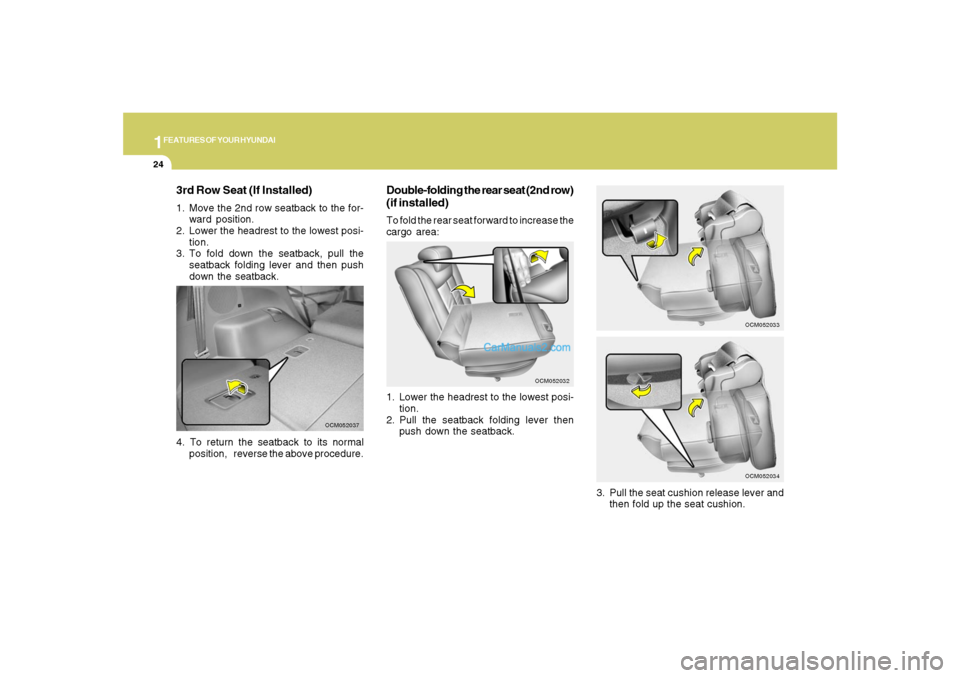
1FEATURES OF YOUR HYUNDAI24
3rd Row Seat (If Installed)1. Move the 2nd row seatback to the for-
ward position.
2. Lower the headrest to the lowest posi-
tion.
3. To fold down the seatback, pull the
seatback folding lever and then push
down the seatback.
Double-folding the rear seat (2nd row)
(if installed)To fold the rear seat forward to increase the
cargo area:
4. To return the seatback to its normal
position, reverse the above procedure.
OCM052037
1. Lower the headrest to the lowest posi-
tion.
2. Pull the seatback folding lever then
push down the seatback.
OCM052032
3. Pull the seat cushion release lever and
then fold up the seat cushion.
OCM052033OCM052034
Page 37 of 355
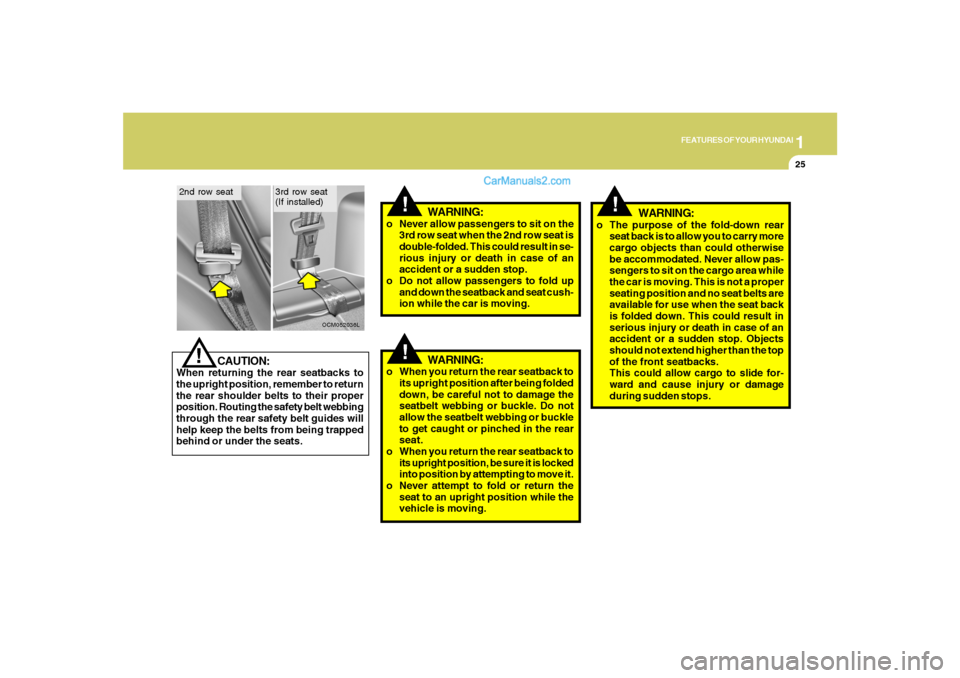
1
FEATURES OF YOUR HYUNDAI
25
!
WARNING:
!
CAUTION:
When returning the rear seatbacks to
the upright position, remember to return
the rear shoulder belts to their proper
position. Routing the safety belt webbing
through the rear safety belt guides will
help keep the belts from being trapped
behind or under the seats.
OCM052036L
!
2nd row seat
3rd row seat
(If installed)
WARNING:
o Never allow passengers to sit on the
3rd row seat when the 2nd row seat is
double-folded. This could result in se-
rious injury or death in case of an
accident or a sudden stop.
o Do not allow passengers to fold up
and down the seatback and seat cush-
ion while the car is moving.
!
WARNING:
o When you return the rear seatback to
its upright position after being folded
down, be careful not to damage the
seatbelt webbing or buckle. Do not
allow the seatbelt webbing or buckle
to get caught or pinched in the rear
seat.
o When you return the rear seatback to
its upright position, be sure it is locked
into position by attempting to move it.
o Never attempt to fold or return the
seat to an upright position while the
vehicle is moving.o The purpose of the fold-down rear
seat back is to allow you to carry more
cargo objects than could otherwise
be accommodated. Never allow pas-
sengers to sit on the cargo area while
the car is moving. This is not a proper
seating position and no seat belts are
available for use when the seat back
is folded down. This could result in
serious injury or death in case of an
accident or a sudden stop. Objects
should not extend higher than the top
of the front seatbacks.
This could allow cargo to slide for-
ward and cause injury or damage
during sudden stops.
Page 39 of 355
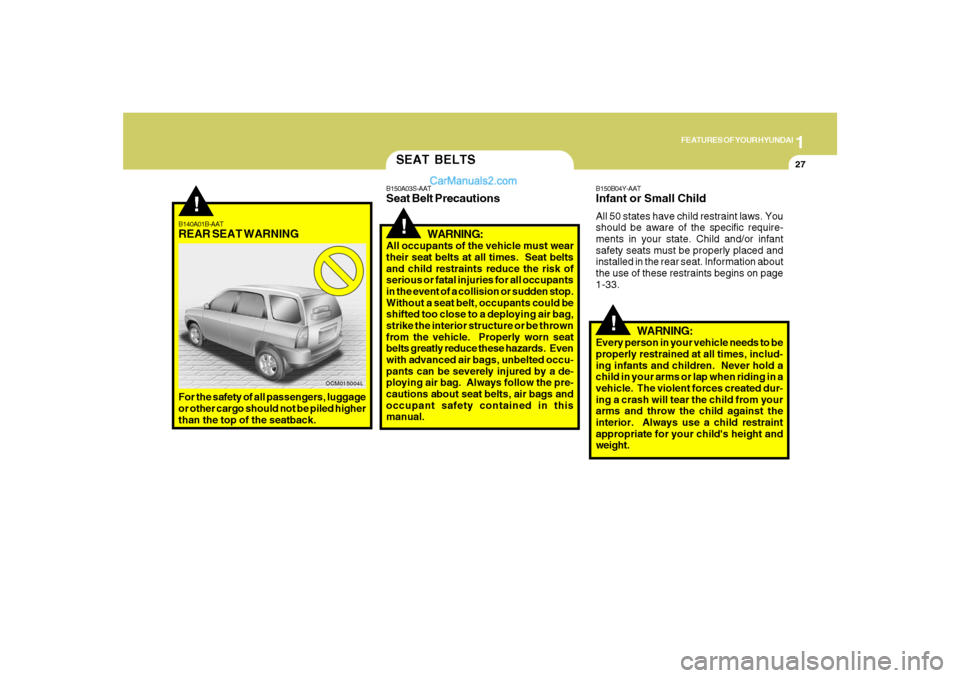
1
FEATURES OF YOUR HYUNDAI
27
!
B140A01B-AATREAR SEAT WARNINGFor the safety of all passengers, luggage
or other cargo should not be piled higher
than the top of the seatback.
OCM015004L
SEAT BELTS
B150B04Y-AATInfant or Small ChildAll 50 states have child restraint laws. You
should be aware of the specific require-
ments in your state. Child and/or infant
safety seats must be properly placed and
installed in the rear seat. Information about
the use of these restraints begins on page
1-33.
!
B150A03S-AATSeat Belt Precautions
WARNING:All occupants of the vehicle must wear
their seat belts at all times. Seat belts
and child restraints reduce the risk of
serious or fatal injuries for all occupants
in the event of a collision or sudden stop.
Without a seat belt, occupants could be
shifted too close to a deploying air bag,
strike the interior structure or be thrown
from the vehicle. Properly worn seat
belts greatly reduce these hazards. Even
with advanced air bags, unbelted occu-
pants can be severely injured by a de-
ploying air bag. Always follow the pre-
cautions about seat belts, air bags and
occupant safety contained in this
manual.
!
WARNING:
Every person in your vehicle needs to be
properly restrained at all times, includ-
ing infants and children. Never hold a
child in your arms or lap when riding in a
vehicle. The violent forces created dur-
ing a crash will tear the child from your
arms and throw the child against the
interior. Always use a child restraint
appropriate for your child's height and
weight.
Page 41 of 355
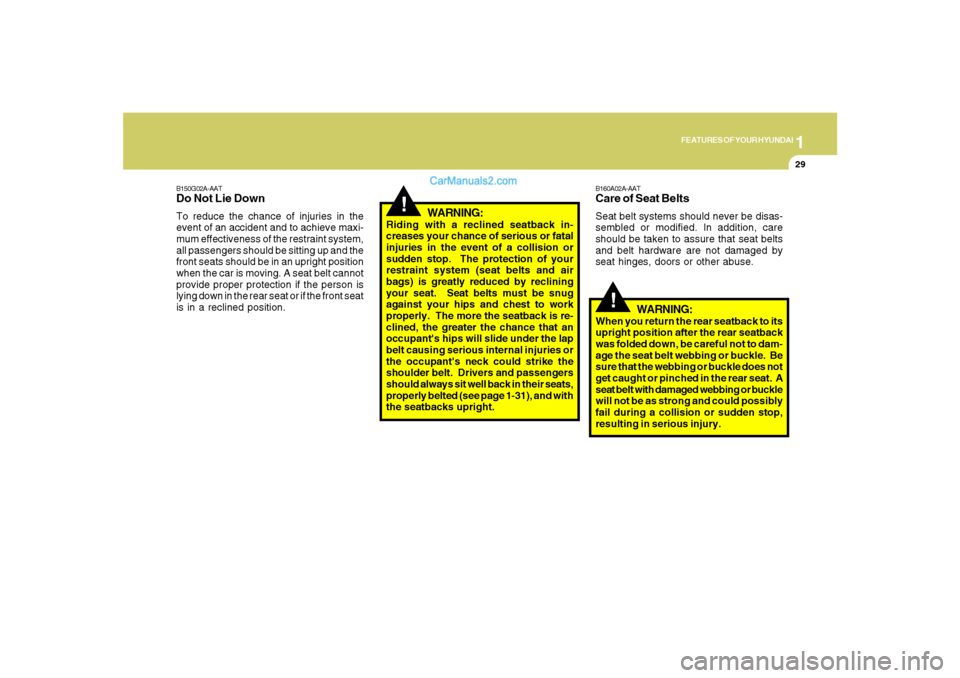
1
FEATURES OF YOUR HYUNDAI
29
B150G02A-AATDo Not Lie DownTo reduce the chance of injuries in the
event of an accident and to achieve maxi-
mum effectiveness of the restraint system,
all passengers should be sitting up and the
front seats should be in an upright position
when the car is moving. A seat belt cannot
provide proper protection if the person is
lying down in the rear seat or if the front seat
is in a reclined position.
WARNING:
Riding with a reclined seatback in-
creases your chance of serious or fatal
injuries in the event of a collision or
sudden stop. The protection of your
restraint system (seat belts and air
bags) is greatly reduced by reclining
your seat. Seat belts must be snug
against your hips and chest to work
properly. The more the seatback is re-
clined, the greater the chance that an
occupant's hips will slide under the lap
belt causing serious internal injuries or
the occupant's neck could strike the
shoulder belt. Drivers and passengers
should always sit well back in their seats,
properly belted (see page 1-31), and with
the seatbacks upright.
!
!
B160A02A-AATCare of Seat BeltsSeat belt systems should never be disas-
sembled or modified. In addition, care
should be taken to assure that seat belts
and belt hardware are not damaged by
seat hinges, doors or other abuse.
WARNING:
When you return the rear seatback to its
upright position after the rear seatback
was folded down, be careful not to dam-
age the seat belt webbing or buckle. Be
sure that the webbing or buckle does not
get caught or pinched in the rear seat. A
seat belt with damaged webbing or buckle
will not be as strong and could possibly
fail during a collision or sudden stop,
resulting in serious injury.
Page 44 of 355
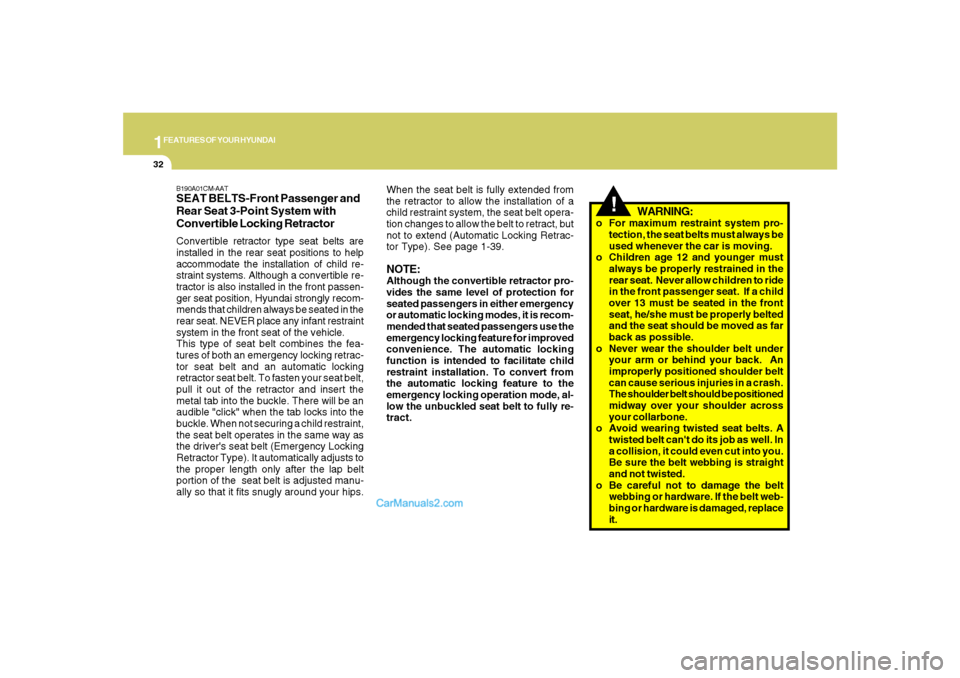
1FEATURES OF YOUR HYUNDAI32
!
WARNING:
o For maximum restraint system pro-
tection, the seat belts must always be
used whenever the car is moving.
o Children age 12 and younger must
always be properly restrained in the
rear seat. Never allow children to ride
in the front passenger seat. If a child
over 13 must be seated in the front
seat, he/she must be properly belted
and the seat should be moved as far
back as possible.
o Never wear the shoulder belt under
your arm or behind your back. An
improperly positioned shoulder belt
can cause serious injuries in a crash.
The shoulder belt should be positioned
midway over your shoulder across
your collarbone.
o Avoid wearing twisted seat belts. A
twisted belt can't do its job as well. In
a collision, it could even cut into you.
Be sure the belt webbing is straight
and not twisted.
o Be careful not to damage the belt
webbing or hardware. If the belt web-
bing or hardware is damaged, replace
it. When the seat belt is fully extended from
the retractor to allow the installation of a
child restraint system, the seat belt opera-
tion changes to allow the belt to retract, but
not to extend (Automatic Locking Retrac-
tor Type). See page 1-39.
NOTE:Although the convertible retractor pro-
vides the same level of protection for
seated passengers in either emergency
or automatic locking modes, it is recom-
mended that seated passengers use the
emergency locking feature for improved
convenience. The automatic locking
function is intended to facilitate child
restraint installation. To convert from
the automatic locking feature to the
emergency locking operation mode, al-
low the unbuckled seat belt to fully re-
tract.
B190A01CM-AATSEAT BELTS-Front Passenger and
Rear Seat 3-Point System with
Convertible Locking RetractorConvertible retractor type seat belts are
installed in the rear seat positions to help
accommodate the installation of child re-
straint systems. Although a convertible re-
tractor is also installed in the front passen-
ger seat position, Hyundai strongly recom-
mends that children always be seated in the
rear seat. NEVER place any infant restraint
system in the front seat of the vehicle.
This type of seat belt combines the fea-
tures of both an emergency locking retrac-
tor seat belt and an automatic locking
retractor seat belt. To fasten your seat belt,
pull it out of the retractor and insert the
metal tab into the buckle. There will be an
audible "click" when the tab locks into the
buckle. When not securing a child restraint,
the seat belt operates in the same way as
the driver's seat belt (Emergency Locking
Retractor Type). It automatically adjusts to
the proper length only after the lap belt
portion of the seat belt is adjusted manu-
ally so that it fits snugly around your hips.
Page 45 of 355
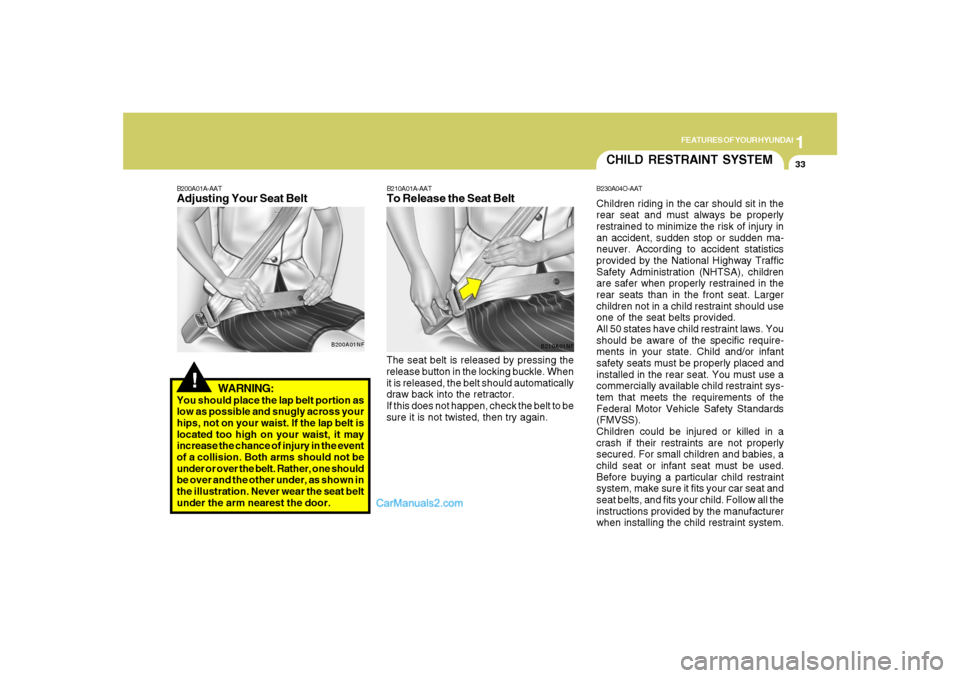
1
FEATURES OF YOUR HYUNDAI
33
WARNING:
You should place the lap belt portion as
low as possible and snugly across your
hips, not on your waist. If the lap belt is
located too high on your waist, it may
increase the chance of injury in the event
of a collision. Both arms should not be
under or over the belt. Rather, one should
be over and the other under, as shown in
the illustration. Never wear the seat belt
under the arm nearest the door.
!
B200A01A-AATAdjusting Your Seat Belt
B200A01NF
The seat belt is released by pressing the
release button in the locking buckle. When
it is released, the belt should automatically
draw back into the retractor.
If this does not happen, check the belt to be
sure it is not twisted, then try again.B210A01A-AATTo Release the Seat Belt
B210A01NF
CHILD RESTRAINT SYSTEMB230A04O-AATChildren riding in the car should sit in the
rear seat and must always be properly
restrained to minimize the risk of injury in
an accident, sudden stop or sudden ma-
neuver. According to accident statistics
provided by the National Highway Traffic
Safety Administration (NHTSA), children
are safer when properly restrained in the
rear seats than in the front seat. Larger
children not in a child restraint should use
one of the seat belts provided.
All 50 states have child restraint laws. You
should be aware of the specific require-
ments in your state. Child and/or infant
safety seats must be properly placed and
installed in the rear seat. You must use a
commercially available child restraint sys-
tem that meets the requirements of the
Federal Motor Vehicle Safety Standards
(FMVSS).
Children could be injured or killed in a
crash if their restraints are not properly
secured. For small children and babies, a
child seat or infant seat must be used.
Before buying a particular child restraint
system, make sure it fits your car seat and
seat belts, and fits your child. Follow all the
instructions provided by the manufacturer
when installing the child restraint system.